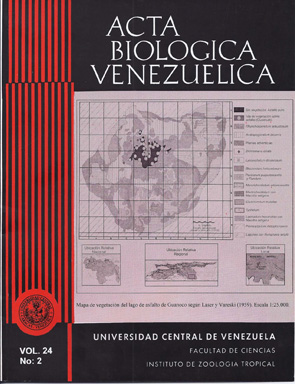FUNCTIONALCONTRIBUTION OF INVERTEBRATES, BACTERIA AND FUNGI TO LEAF DECOMPOSITIONIN A BLACK WATER TROPICAL RIVER
Palabras clave:
Leaf breakdown, invertebrates, bacteria, fungi, Caroní River.Resumen
A functional analysis on leaf breakdown under flooded conditions of four common tree species of the Leguminosaefamily: Bauhinia sp. (PV), Pithecellobium pedicellare (HP,), Albizia glabripetala (SC) and Centrolobium paraense(C) and leaf litter (LL) from the floor of the dry forests around Caruachi Reservoir was conducted in the lower CaroníRiver basin, Venezuelan Guiana. Leaf bags technique (5 mm 0 mesh) was used over a 4-week period. Rate of leafweight lost (k) was determined by the Olson model (1963). Decay of leaves by bacteria, fungi and macroinvertebrateswas photographed along with the decomposition period. Soft leaved species (SL) coming from SC and C decomposedmore rapidly (k = 0.0373 and k = 0.0285 respecti-vely) than Hard leaved species (HL) coming from HP and PV andLL (k = 0.0188 and k = 0.0143 k = 0.0229 respectively at 28 days ); SL (C and SC) had a greater lost (54% - 64%)of its initial mass within 4 week compared to HL (PV and HP) (33 - 44 %) and litter (47%). The former high rales(SL) were probably related to a softer texture favoring strong biological activity. Up to 1087 and 950 invertebratesper leaf bag were found on SL and HL, respectively and 480 on LL after 21 days. Shredders accounted for <1% or theabsence of the total numbers and biomass, meanwhile, Recolectors/Scrapers reached to >90%. Fungal density reachedat 60 (CFU)/mg of the detrital mass and bacterial abundance 476.7 and 395.0 on HL and SL and 398.3 (CFU)/ mgon LL, suggesting that bacteria and fungi contributed considerably to leaf mass loss. The difference in breakdownrates between leaf species was consisten! with the faster colonization of SL (SC and C) by macroinvertebrates. Therapid breakdown of tropical leaves combined with a low influence by shredders in this study seems to present similarpatterns as previous findings (Covich et al., 1999 and Benstead, 1996). In this experiment, we found a strong influenceby Recolectors/Scrapers, evidenced by photographs. The high bacterial, double role of macroinvertebrates and fungalactivities associated with rapid leaf breakdown appear to be important on leaf processing in this tropical stream.


